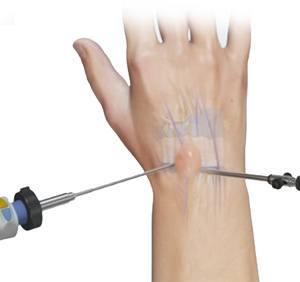Arthroscopic Ganglion Excision

Ganglion cysts are fluid-filled lumps that most commonly develop along the tendons or joints of wrists or hands. It looks like a water balloon on a stalk and contains a clear fluid or gelatinous material. Ganglion cysts are noncancerous, generally harmless and disappear without any treatment. However, if the cyst becomes painful or interferes with hand movement, they can be treated non-surgically or removed surgically.
Causes
The underlying cause for ganglion cysts is not clearly known, but seems to develop when the synovial tissue bulges outwards. It is commonly seen in women and young people between 15 to 40 years of age. Osteoarthritis, tendon or joint injuries, and repeated stress applied to the wrist can lead to the formation of the cysts.
Symptoms
Ganglion cysts can manifest as a visible bump or can be hidden under the skin. They may or may not be painful. If a cyst presses on a nerve it can cause pain, muscle weakness and a tingling sensation.
Diagnosis
Your doctor will diagnose ganglion cyst by performing a physical examination. Your doctor may apply pressure to the cyst to identify any tenderness or discomfort. The region may be illuminated with a torch light to determine if it is solid or filled with liquid. Additionally, X-rays, MRI or ultrasound may be ordered to help rule out tumours and arthritis. Diagnosis is confirmed by needle aspiration, where a thin needle is inserted into the cyst and the fluid is removed. The fluid in a ganglion cyst will be translucent, or thick and clear.
Conservative Treatment Options
In many cases, ganglion cysts disappear without any treatment. If bothersome, your doctor make recommend wearing a wrist brace or splint to immobilize the area and allow the cyst to shrink.
Often, Aspiration is the first line of treatment suggested by your surgeon. Your hand surgeon will clean the skin around the cyst and numb the region using local anaesthesia. A syringe is then inserted into the cyst and the fluid is drained out. Your surgeon then injects a steroid to prevent reoccurrence and places a bandage over the site of injection.
Surgery
If conservative treatment options are not successful and the cyst continues to be painful, limits your activity, causes numbness or tingling of the hand or fingers, then your doctor may recommend surgery to remove the ganglion cyst.
Surgery can be open technique or minimally invasive with arthroscopy, where a small camera is inserted for the surgeon to clearly view the area of operation. The surgery can be conducted under local or general anaesthesia. The area of the ganglion cyst is cleansed and an incision is made across the cyst. The contents of the cyst are then excised along with its root and the opening is sutured and bandaged.
Post-op Care
Both aspiration and surgery are outpatient procedures and you will be able to go home on the same day. If you have undergone surgery, you should be able to resume daily activities within 2 to 6 weeks. Your hand will be bandaged and placed in a sling. You will be prescribed medication to control swelling, pain and stiffness. If pain or stiffness persists, you may need further treatment with occupational or physical therapy.
Risks and Complications
Ganglion cyst removal is a fairly safe procedure and is associated with minimum risks or complications. Chances of recurrence are 20% with aspiration and 10% with surgery. If the cyst develops again, your doctor will suggest surgery. A second surgery decreases further occurrence of the cyst but increase the risk of damage to surrounding nerves.
Conclusion
Ganglion cysts are fluid-filled sacs in the hand or feet. They are harmless and gradually subside, but pain and immobility may require treatment. Non-surgical and surgical procedures are safe and are associated with minor risks and complications.
Other Hand & Wrist List
- Wrist Joint Replacement
- Trapeziectomy + LRTI
- Hand Tendon Release
- ORIF
- Vascularized Bone Grafting
- Wrist Ligament Reconstruction
- Total Wrist Arthrodesis
- Tendon Reconstruction
- Microsurgery Nerve Repair/Nerve Grafting
- Arthroscopic Wrist Surgery
- Collagenase Injection
- Excision of Tumour
- Fasciectomy
- Carpal Tunnel Release

 Menu
Menu






